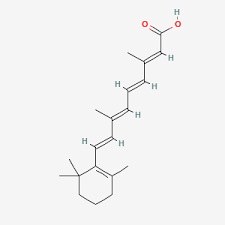
Tretinoin Cream 0.01%
Afhentning er ikke tilgængelig lige nu
NOT FOR HUMAN CONSUMPTION
Tretinoin is a topical retinoid (vitamin-A derivative) that binds retinoic-acid receptors RAR-α/β/γ in keratinocytes and fibroblasts, reprogramming gene expression to normalize follicular desquamation, reduce inflammation, and rebuild dermal matrix. It’s prescription-only in most regions; strengths typically 0.025%–0.1% as cream/gel/micro/cream-in-lotion.
Additional Benefits of Tretinoin Cream Now Under Investigation
| Benefit | Key take-aways |
|---|---|
| 1 Comedolysis & acne clearance | Gold-standard comedolytic: decreases keratinocyte cohesion in the follicular infundibulum, normalizes turnover, and reduces new microcomedones. Comparable or superior to adapalene for comedones; pairs well with benzoyl peroxide (staggered) for inflammatory lesions. <br/><em>Journal of the American Academy of Dermatology; British Journal of Dermatology</em> |
| 2 Maintenance therapy for acne | After induction, nightly or 3–5×/wk use prevents relapse by suppressing microcomedone formation—reduces need for repeated antibiotic courses. <br/><em>JAAD; Dermatology</em> |
| 3 Photoaging reversal | Long-term use (3–12 months) reduces fine wrinkles, mottled hyperpigmentation, and tactile roughness by ↑ epidermal turnover and dermal collagen I/III with ↓ MMP-1. <br/><em>New England Journal of Medicine; Archives of Dermatology</em> |
| 4 Dyspigmentation & melasma adjunct | In triple therapy (tretinoin + hydroquinone + mild steroid), improves melasma; as maintenance, reduces rebound after bleaching courses. <br/><em>Journal of the American Academy of Dermatology; International Journal of Dermatology</em> |
| 5 Actinic damage field care | Improves actinic lentigines and photodamage; as part of a regimen may reduce field cancerization markers (adjunct to 5-FU/photodynamic therapy). <br/><em>JAMA Dermatology; Photodermatology Photoimmunology & Photomedicine</em> |
| 6 Texture/pores & oil balance | Smoother stratum corneum, reduced visible pores, and lower sebum congestion with sustained use. <br/><em>Cutis; Skin Research & Technology</em> |
| 7 Scar remodeling (acne) | Modest improvement in atrophic acne scars over months; greater gains when combined with needling, TCA CROSS, fractional lasers (staged). <br/><em>Dermatologic Surgery; Lasers in Surgery and Medicine</em> |
| 8 Pre- and post-procedure skin prep | “Retinization” before resurfacing speeds re-epithelialization and improves outcome uniformity; post-procedure re-start (after re-epithelialization) maintains gains. <br/><em>Aesthetic Surgery Journal; Dermatologic Therapy</em> |
| 9 Keratosis pilaris/roughness | Off-label nightly application softens KP and improves feel when tolerated, alternating with moisturizers/urea. <br/><em>Clinical, Cosmetic and Investigational Dermatology</em> |
2. Molecular Mechanism of Action
2.1 Receptor Pharmacodynamics
-
RAR activation (β/γ-predominant in epidermis) → transcriptional changes: ↑ keratinocyte proliferation/differentiation, ↑ collagen I/III & hyaluronan, ↓ MMP-1, ↓ TLR-mediated inflammation, ↑ filaggrin/loricrin after adaptation.
-
Follicular normalization: Reduces corneocyte cohesion, expels existing microcomedones, prevents new ones.
2.2 Down-stream Biology
| Pathway | Functional outcome | Context |
|---|---|---|
| RAR–RXR transcription | Normalized desquamation, comedolysis | Acne |
| AP-1/MMP down-regulation | Collagen preservation, wrinkle reduction | Photoaging |
| TLR/NF-κB restraint | ↓ IL-8/IL-1β; anti-inflammatory | Inflammatory acne |
| Dermal fibroblast activation | ↑ Collagen/GAGs | Texture/firmness |
3. Pharmacokinetics (topical)
-
Absorption: Minimal systemic absorption when used as directed; confined largely to epidermis/upper dermis.
-
Onset: Acne: visible change 4–8 wks, peak 12–16 wks; photoaging: 3–6 mo for texture/tone, 6–12 mo for wrinkles.
-
Formulations: Cream (more emollient), gel (oily/acne-prone), microsphere/micro-encapsulated and cream-in-lotion (better tolerability).
4. Clinical Evidence (high-level)
-
Multiple randomized trials show tretinoin reduces lesion counts vs vehicle and improves photoaging vs vehicle with histologic collagen increase.
-
Combination regimens (e.g., benzoyl peroxide AM + tretinoin PM) outperform monotherapy for inflammatory acne; triple-combination creams excel for melasma short-term with tretinoin for maintenance.
Evidence quality note: Decades of Level 1–2 dermatology evidence support acne and photoaging indications; melasma and scar remodeling rely on combination protocols and longer timelines.
5. Practical Use (how to start & succeed)
-
Start low, go slow: Apply pea-sized amount to entire face at night, 2–3×/week → build to nightly as tolerated.
-
Moisturizer sandwich: Moisturizer → tretinoin → moisturizer (or buffer by mixing the first weeks).
-
AM routine: Gentle cleanse → broad-spectrum SPF 30–50 (daily) → non-comedogenic moisturizer.
-
Pairing:
-
Benzoyl peroxide: Use AM BP / PM tretinoin (older tretinoin can be oxidized by BP).
-
Topical antibiotics: Limit duration; always combine with BP to curb resistance.
-
Actives to pace: Strong AHAs/BHAs/ascorbic acid and exfoliants—alternate days to reduce irritation.
-
-
Expectations: Mild purging/irritation weeks 2–6; stick with regimen unless severe.
6. Safety and Tolerability
-
Common: Erythema, dryness, peeling, burning/sting, transient acne flare (“purge”). Usually settles by week 6–8 with moisturization and frequency adjustment.
-
Photosensitivity: Heightened—daily sunscreen is mandatory; avoid tanning beds.
-
Sensitive skin/eczema/rosacea: Introduce cautiously; consider lower strength, cream-in-lotion, or alternate-night use.
-
Peri-procedure: Stop 3–7 days before medium/deep peels, ablative lasers, or waxing; resume after re-epithelialization.
-
Pregnancy: Avoid—topical systemic exposure is low, but retinoids are generally contraindicated in pregnancy; discuss contraception if of child-bearing potential.
-
Breastfeeding: Typically acceptable on small areas, avoid infant skin contact with treated sites.
-
Contraindications: True retinoid allergy, severe dermatitis at site.
-
Drug/active interactions: Benzoyl peroxide (use separate timing), potent keratolytics ↑ irritation, photosensitizing drugs ↑ burn risk.
Comparative matrix (topical retinoids)
| Feature | Tretinoin | Adapalene | Tazarotene |
|---|---|---|---|
| Comedolytic | Strong | Strong | Strong |
| Anti-inflammatory | Moderate | Strongest | Strong |
| Photoaging data | Robust | Moderate | Moderate |
| Irritation | Moderate | Lowest | Highest |
| Pregnancy | Avoid | Avoid | Contraindicated |
7. Who benefits most
-
Acne (comedonal ± inflammatory), especially for maintenance post-clearance.
-
Photodamage (fine wrinkling, dyschromia, roughness).
-
Melasma (with triple therapy) and post-acne dyspigmentation.
-
Texture/pores concerns in oily or combination skin (with moisturization).
8. Future Directions
-
Barrier-smart vehicles (ceramide-rich, micro-encapsulation) to reduce irritation with equal efficacy.
-
Day-stable formulations that coexist with peroxides/ascorbic acid.
-
Adjunct protocols with energy-based devices and microneedling for scars and photodamage.
-
Biomarker-guided retinization (filaggrin/TEWL metrics) to personalize ramp-up.
Selected References
-
New England Journal of Medicine; Archives of Dermatology — Photoaging reversal and histologic collagen changes with tretinoin.
-
Journal of the American Academy of Dermatology; British Journal of Dermatology — Acne efficacy, maintenance data, and combination regimens.
-
International Journal of Dermatology; JAMA Dermatology — Melasma triple-therapy and field cancerization/actinic damage contexts.
-
Dermatologic Surgery; Lasers in Surgery and Medicine — Scar remodeling synergy with procedures.
-
Photodermatology, Photoimmunology & Photomedicine; Skin Research & Technology — Pigment, texture, and pore appearance outcomes; photobiology and sunscreen pairing.

